Geschichte des Literaturtempels
Der Literaturtempel wurde 1070 von Kaiser Ly Thanh Tong gegründet und war Konfuzius gewidmet, was die hohe Wertschätzung der vietnamesischen Kultur für Wissenschaft und Literatur widerspiegelt. Dieser Tempel war nicht nur ein Ort der Verehrung, sondern auch ein wichtiges Zentrum des Lernens und repräsentierte den tiefen Respekt für Bildung in Vietnam.
Nur sechs Jahre nach seiner Gründung wurde der Tempel zur Heimat des Quoc Tu Giam, auch bekannt als die „Schule für die Blume der Nation“, die als erste Universität des Landes gilt. Ursprünglich dazu gedacht, die Söhne des Adels in konfuzianischem Denken und Staatsdienst auszubilden, öffnete die Universität ihre Türen auch für talentierte Individuen aus der Allgemeinbevölkerung, ein Beweis für die inklusive Vision der Bildung zu jener Zeit.
Hier fanden von 1443 bis 1778 alle drei Jahre nationale Prüfungen statt, die für diejenigen, die in die Verwaltung des Landes eintreten wollten, von großer Bedeutung waren. 1802 verlegte Kaiser Gia Long dieses Bildungsinstitut in die neue Hauptstadt Hue, was einen bedeutenden Wandel im akademischen Zentrum des Landes markierte.
Trotz mehrerer Restaurierungen im Laufe der Jahrhunderte hat der Literaturtempel weitgehend sein ursprüngliches Design bewahrt und steht heute als ein hervorragendes Beispiel traditioneller vietnamesischer Architektur. Er bleibt nicht nur ein historischer Ort, sondern auch ein Symbol für Vietnams unerschütterliches Engagement für Bildung und ein Zeugnis des reichen kulturellen Erbes der Nation.
Höhepunkte des Literaturtempels
Der Eingang zum Literaturtempel befindet sich in der Quoc Tu Giam Straße. Durch das Haupttor, Van Mieu Mon, betreten die Besucher einen 2,5 Hektar großen Komplex. Diese historische Stätte ist in fünf verschiedene Höfe unterteilt, die jeweils durch Mauern getrennt sind, und entfaltet eine Reihe architektonischer und natürlicher Wunder.
1. Das Tor
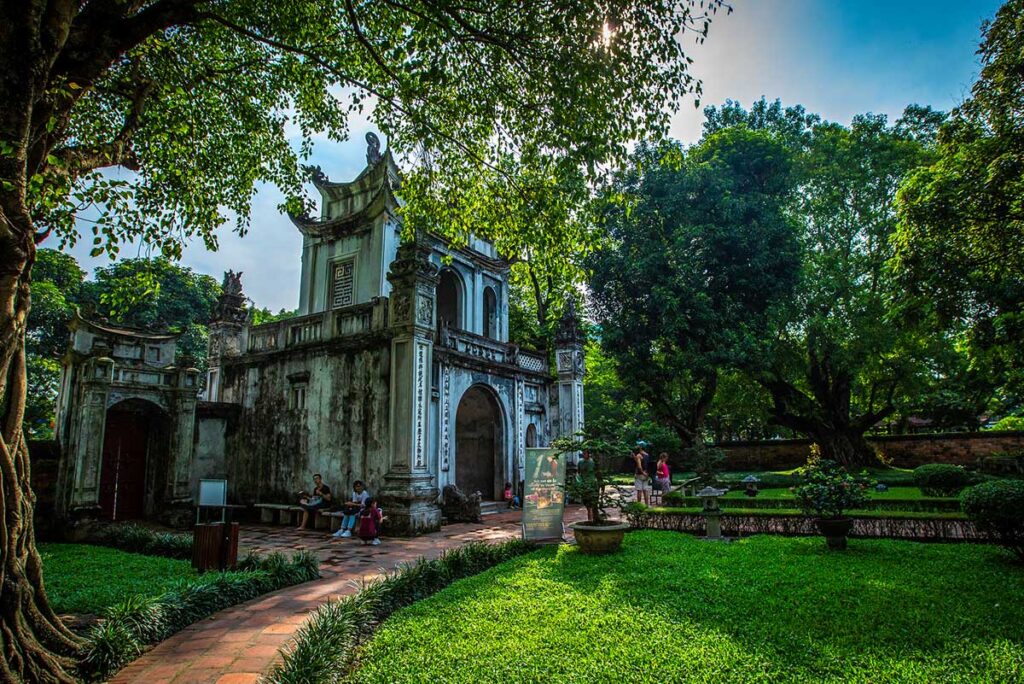
Die ersten beiden Höfe sind ohne Gebäude, aber reich an landschaftlicher Schönheit. Der erste Hof umfasst den Haupteingang und führt zum Großen Mittleren Tor, flankiert von zwei kleineren Seiteneingängen. Es gibt zwei kleine Teiche auf beiden Seiten eines Gartens und drei Wege: der zentrale Weg war dem König und seiner Familie vorbehalten, die seitlichen Wege den Studenten und der Öffentlichkeit. Dieser ruhige Raum setzt den Ton für die friedliche Atmosphäre, die den Literaturtempel durchdringt.
2. Hof und Pavillon
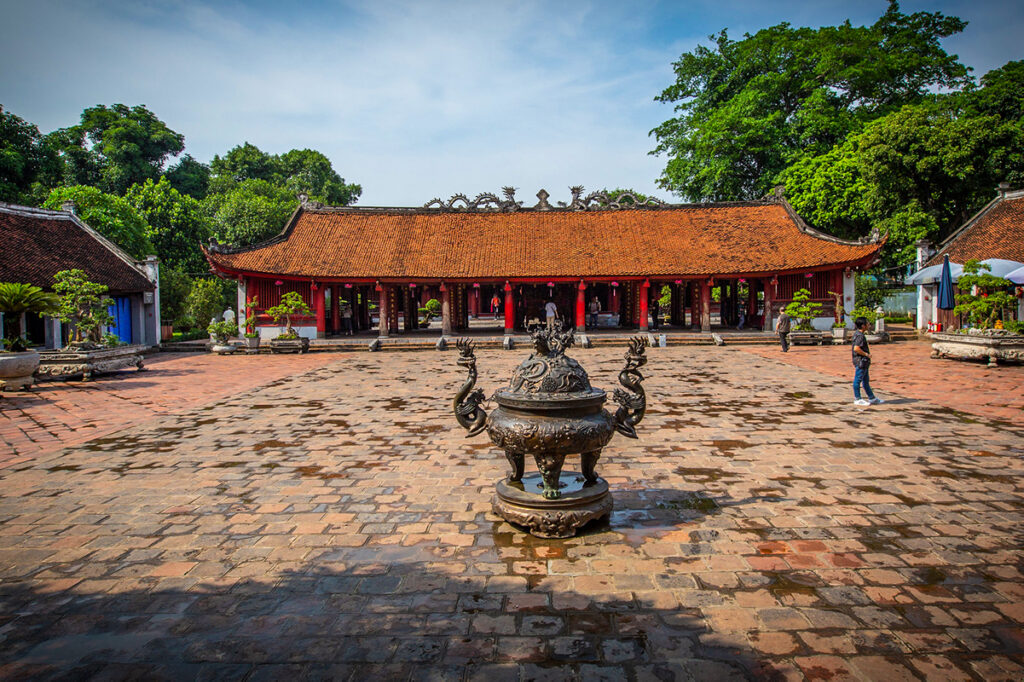
Den zweiten und dritten Hof verbindet der exquisite Khue Van Cac, ein Holzpavillon, der für seine historische Bedeutung und Schönheit bekannt ist. Dieser Pavillon, einst ein Ort, an dem Gelehrte Gedichte rezitierten und literarische Diskussionen führten, steht heute als malerisches Wahrzeichen, das Fotografen und Künstler anzieht. Er ist so emblematisch für die vietnamesische Kultur, dass er auf dem 100.000 vietnamesischen Dong-Schein abgebildet ist.
3. Der Teich
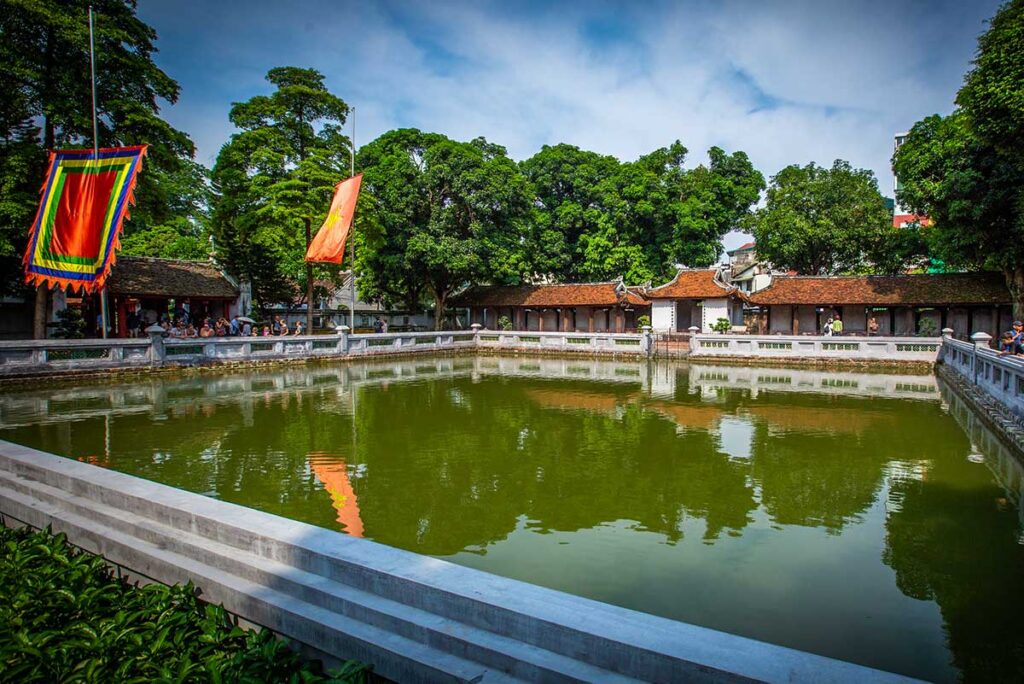
Im Herzen des dritten Hofes liegt der Thien Quang Tinh, ein ruhiger Teich, der symbolisch als Spiegel dient, der die Essenz des Universums reflektiert und die Studenten zur Selbstreflexion anregt. Den Garten flankieren 41 Stelen, die auf Steinschildkröten montiert sind und die Gelehrten ehren, die in den nationalen Prüfungen hervorragende Leistungen erbracht haben. Diese Stelen, die bis ins Jahr 1484 zurückreichen, sind historische Zeugnisse der akademischen Erfolge von über 1.300 Doktoranden.
Im dritten Hof des Literaturtempels befindet sich ein wichtiges und symbolisches Merkmal: die Steinschildkröten. Diese Schildkröten tragen 82 Stelen auf ihren Rücken, die als Denkmäler für die 1.306 Gelehrten dienen, die zwischen dem 15. und 18. Jahrhundert die strengen nationalen Prüfungen bestanden haben. Die Schildkröten sind ein bedeutendes Element im Tempelkomplex und symbolisieren in der vietnamesischen Kultur Langlebigkeit und Weisheit
4. Tor des Großen Erfolgs
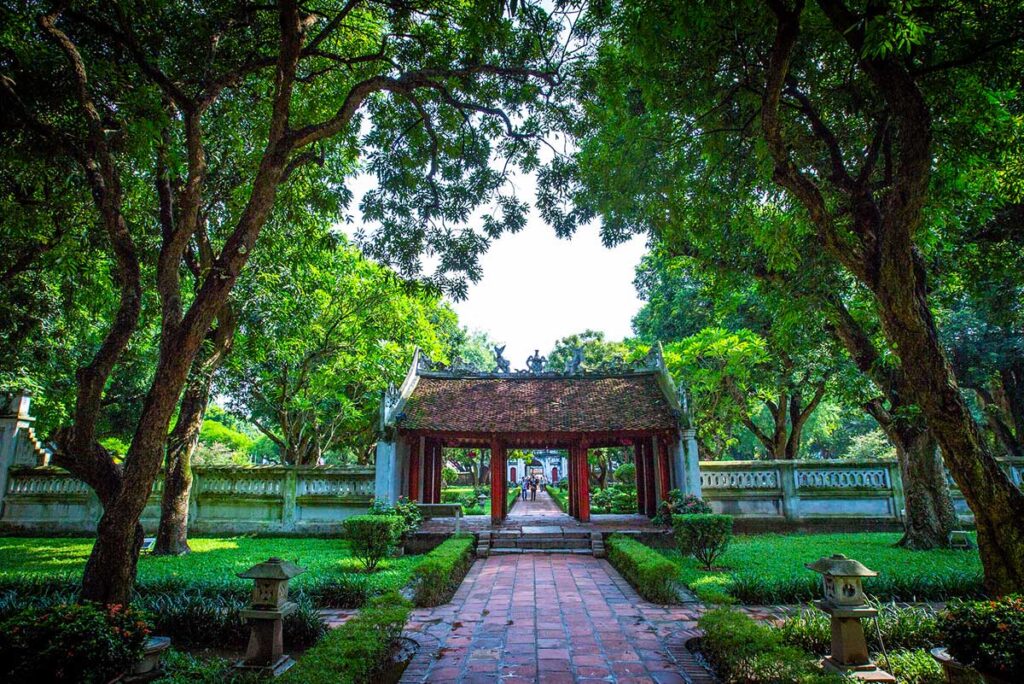
Der vierte Hof beherbergt den Haupttempel der Literatur, der Statuen von Konfuzius und seinen Schülern enthält. Dieser heilige Bereich bleibt ein Ort der Verehrung, besonders für Studenten, die während der Prüfungszeiten um Segen bitten.
5. Die Kaiserliche Akademie
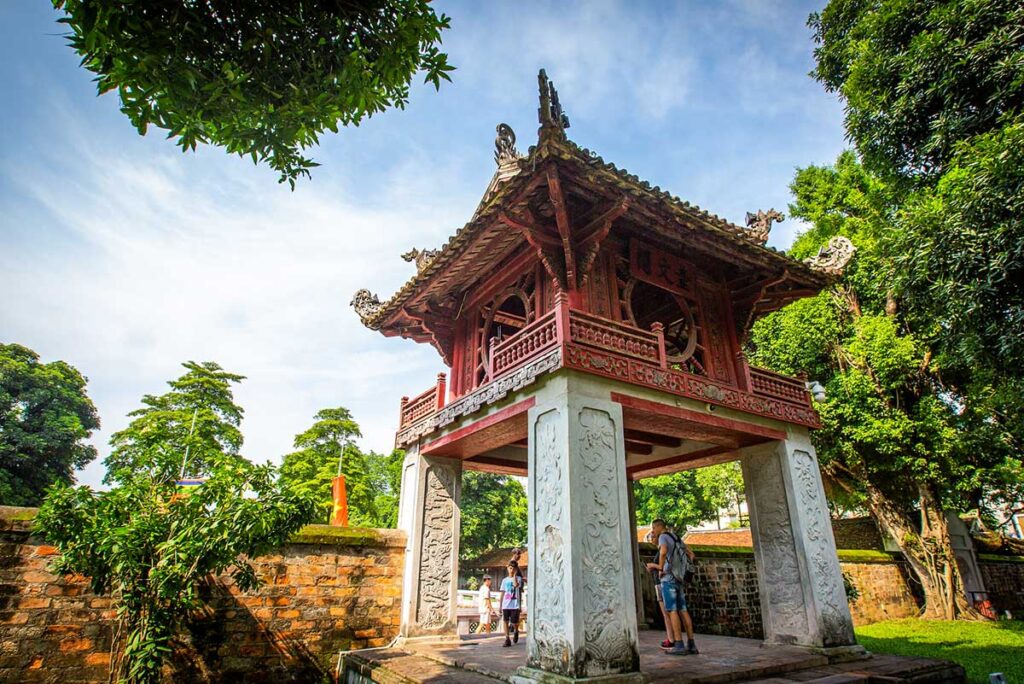
Der letzte Hof beherbergte einst die Bibliothek und die Kaiserliche Akademie, das Epizentrum des Lernens für die Beamten des Landes. Obwohl sie 1946 während des Ersten Indochinakrieges zerstört wurde, wurde 2000 eine Rekonstruktion abgeschlossen. Dieses neue Gebäude dient als Ausstellungsraum und zeigt Artefakte wie die traditionellen Gelehrtenuniformen, die den Besuchern einen Einblick in Vietnams reiche akademische Vergangenheit gewähren.
Besuch des Tempels
Adresse & Öffnungszeiten
Der Literaturtempel, auch bekannt als Chua Van Mieu, befindet sich im Dong Da Bezirk, etwa 1 km südlich des Ho Chi Minh Mausoleums, einem bedeutenden kulturellen und historischen Gebiet in Hanoi.
- Adresse: 58 Quốc Tử Giám, Văn Miếu, Đống Đa. Der Ort ist leicht zugänglich und kann auf Google Maps gefunden werden. (Google Maps Standort)
- Öffnungszeiten: Der Tempel ist täglich von 8:00 bis 16:30 Uhr geöffnet, was den Besuchern ausreichend Zeit gibt, um die reiche Geschichte zu erkunden.
Eintrittspreis
- Erwachsene: 20.000 VND
- Kinder: 10.000 VND
Wie man dorthin kommt
Der Tempel der Literatur liegt etwa 2 km vom Old Quarter in Hanoi entfernt und ist auf verschiedene Weise erreichbar:
- Taxi oder Cyclo Fahrt: Sowohl Taxis als auch traditionelle Cyclos kennen den Ort gut. Eine Cyclo-Fahrt bietet eine einzigartige und gemütliche Möglichkeit, die Stadt zu sehen.
- Zu Fuß: Wenn du gerne zu Fuß unterwegs bist, ist das vom Old Quarter aus machbar. Unterwegs kommst du an der interessanten Hanoi Train Street vorbei, wo ein aktives Bahngleis durch ein Wohnviertel führt.
Kleiderordnung
Als verehrter historischer Ort und Tempel wird von den Besuchern erwartet, dass sie sich respektvoll kleiden:
- Vermeide es, Hüte, Shorts, Miniröcke oder ärmellose Shirts zu tragen, besonders in den Andachtsbereichen.
- Es ist wichtig, eine respektvolle Haltung zu bewahren, was auch bedeutet, leise zu sein und während des Aufenthalts keine Speisen oder Getränke zu sich zu nehmen.
Weitere Sehenswürdigkeiten rund um den Literaturtempel
Der Literaturtempel liegt etwa 2 km vom Old Quarter in Hanoi entfernt und in der Nähe mehrerer wichtiger Attraktionen, die innerhalb von 15 Minuten zu Fuß erreichbar sind:
- Kaiserliche Zitadelle von Thang Long: In der Nähe des Literaturtempels liegt dieses UNESCO-Weltkulturerbe mit alten Palästen und Relikten der historischen Hauptstadt Vietnams. Besucher können alte Strukturen und ruhige Gärten erkunden und nahe der Lenin-Statue und dem Vietnam Militärgeschichtlichen Museum eintreten.
- Ba Dinh Platz und Umgebung: Nördlich des Tempels befindet sich der Ba Dinh Platz, umgeben von wichtigen Sehenswürdigkeiten:
- Ho Chi Minh Mausoleum: Die letzte Ruhestätte von Ho Chi Minh, einer Schlüsselperson der vietnamesischen Geschichte, bietet Einblicke in sein Leben und Erbe.
- Ho Chi Minh Museum und Stelzenhaus: Diese Stätten geben einen Einblick in Ho Chi Minhs Leben und Führung, zeigen seine bescheidenen Wohnräume und umfassende historische Ausstellungen.
- Einsäulenpagode: Ein bekannter Tempel in Hanoi, bekannt für seine einzigartige Architektur und kulturelle Bedeutung, in der Nähe des Mausoleums gelegen.
